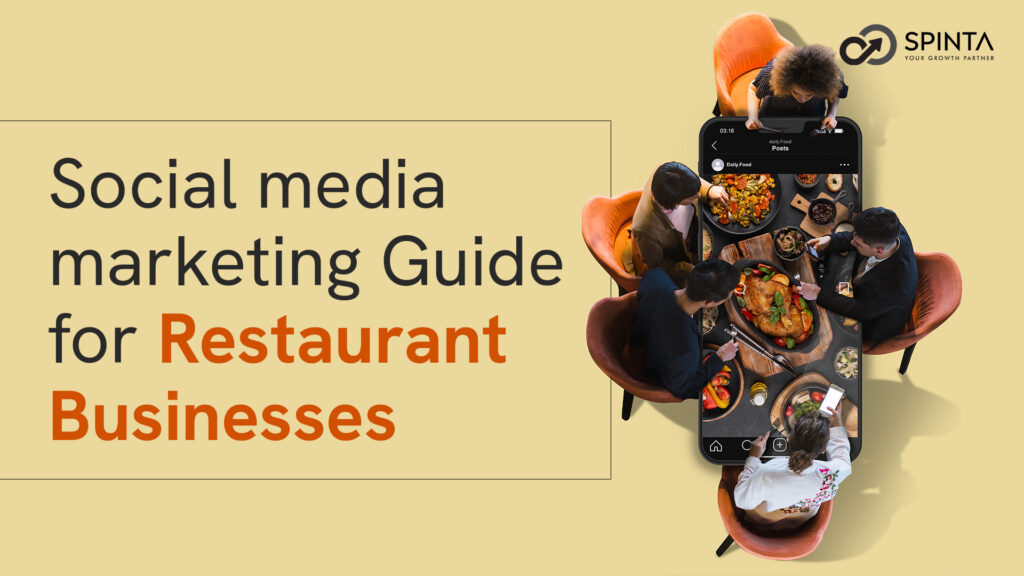In the world of the culinary industry, where the aroma of delicious dishes competes for attention, restaurant owners can’t afford to overlook the power of social media. If you own a restaurant and aren’t leveraging the potential of platforms like Instagram and Facebook, you might be missing out on a golden opportunity to connect with thousands, if not millions, of potential customers. In this comprehensive guide, we’ll look into the reasons why social media marketing for restaurants is important and explore effective strategies to help you grow your digital reach.
Why social media marketing for restaurants is crucial?
Brand Awareness:
With over 3 billion people globally using social media, platforms like Instagram and Facebook present an unparalleled opportunity to create brand awareness. By strategically posting tempting images of your culinary creations, showcasing kitchen expertise through videos, and offering behind-the-scenes glimpses, you can captivate an ever-growing audience.
Engage with User-Generated Content (UGC):
The interactive nature of social media allows you to boost engagement by actively encouraging and sharing UGC. Invite your customers to share pictures, graphics, or stories related to their experiences at your restaurant. This not only promotes your establishment but also encourages others to visit and share their own content.
Address customer concerns:
Social media provides a platform for customers to express their feedback, both positive and negative. Embrace this opportunity to interact directly with your patrons. Responding to reviews, addressing concerns, and demonstrating genuine care about their experience can enhance your reputation and foster customer loyalty.
Get Feedback:
Initiate healthy discussions on social media to gather valuable feedback. Pose questions about potential menu changes, new items, or special promotions. Understanding your customers’ preferences can guide your business decisions and help you tailor your offerings to better suit their needs.
Increase your reach:
Utilize location tagging features on platforms like Instagram and Facebook to reach new customers in your target geographical area. This not only attracts locals but also entices tourists searching for a local dining experience.
Social media strategy for restaurants
In the realm of digital marketing for restaurants, certain social media strategy for restaurants can amplify your digital presence and drive customer engagement. Let’s explore these strategies while weaving in key terms such as “social media marketing for restaurants” and “marketing a restaurant with social media.”
1. Craft Compelling Visuals:
. Utilize high-quality images of your signature dishes, share captivating videos of your chefs in action, and maintain a consistent theme that reflects your brand identity. This approach enhances the overall aesthetic of your social media profiles, attracting more followers and potential customers.
2. Leverage Trending Hashtags:
Utilize the power of popular restaurant marketing hashtags like #foodporn and #foodphotography. Incorporate these hashtags into your posts to increase visibility and reach a broader audience. By aligning your content with trending topics, you position your restaurant to be discovered by users exploring these popular social media tags.
3. Interactive Polls and Surveys:
Engage your audience by using interactive features such as polls and surveys. Pose questions about their favorite dishes, desired menu additions, or preferred dining experiences. This social media strategy for restaurants not only sparks meaningful conversations but also provides valuable insights into your customers’ preferences, guiding your restaurant’s strategic decisions.
4. Behind-the-Scenes Stories:
Offer a glimpse into the heart of your restaurant by sharing behind-the-scenes stories. Introduce your kitchen staff, showcase the preparation process of a popular dish, or highlight special events. Providing a personal touch fosters a connection with your audience, making them feel like insiders in your culinary journey.
5. Collaborate with Influencers:
Extend your restaurant’s reach by collaborating with social media influencers. Identify influencers whose values align with your brand and invite them to experience your culinary offerings. In exchange for their reviews and posts, offer incentives such as complimentary meals or exclusive discounts.
6. Seasonal Menu Showcases:
Leverage the craving for novelty by promoting seasonal menu items on your social media platforms. Create anticipation by unveiling new dishes, and use visually appealing content to showcase the uniqueness of each seasonal offering. This social media strategy for restaurants not only attracts customers seeking fresh experiences but also positions your restaurant as dynamic and innovative.
7. Engage with Customer Reviews:
Actively participate in conversations initiated by customer reviews. Respond promptly to both positive and negative feedback, expressing gratitude for compliments and addressing concerns with empathy. This social media strategy for restaurants demonstrates your commitment to customer satisfaction, fostering a positive online reputation.
Social Media Advertising for Restaurants: Maximizing Visibility and Ad Impact
The power of social media advertising for restaurants is no longer an option but a necessity. To supercharge your restaurant’s visibility and draw in a crowd of hungry patrons, consider the following strategies for a targeted and impactful social media advertising campaign.
Invest Strategically:
When delving into social media advertising for restaurants, think of it as a targeted investment rather than a mere expense. Platforms like Facebook and Instagram offer robust advertising tools that allow you to define your target audience with precision. Identify key demographics, interests, and geographical locations relevant to your restaurant to ensure that your ad spend is utilized efficiently.
Choose the Right Platforms:
Not all social media platforms are created equal. Conduct research to understand where your target audience spends their time online. While Facebook and Instagram are popular choices, platforms like Twitter, Pinterest, or even TikTok might be effective depending on your restaurant’s concept and the demographics you aim to reach.
Experiment with Ad Formats:
Diversify your approach by experimenting with various ad formats. Whether it’s carousel ads, video ads, or sponsored posts, different formats resonate with different audiences. Conduct A/B testing to identify the formats that generate the most engagement and conversion for your restaurant.
Compelling Visuals and Messaging:
In the world of social media advertising for restaurants, visuals are key. Invest time and resources in creating high-quality, visually appealing content that showcases your restaurant’s ambiance, signature dishes, and unique selling points. Craft compelling messaging that not only informs but also entices the audience to take action.
Target Local Audiences:
One of the most significant advantages of social media advertising for restaurants is the ability to target local audiences effectively. Use geographical targeting features to reach potential customers in your restaurant’s vicinity. This not only maximizes your ad’s relevance but also increases the likelihood of converting online engagement into foot traffic.
Time Your Campaigns:
Timing is crucial in the world of digital advertising. Consider peak hours and days when your target audience is most active on social media. Tailor your ad scheduling to align with these patterns, ensuring that your promotional content reaches your audience when they are most receptive.
Implement Conversion Tracking:
To gauge the success of your social media advertising for restaurants, implement conversion tracking. Whether it’s tracking reservations, online orders, or website visits, having measurable goals allows you to assess the real impact of your campaigns. Adjust your strategy based on these insights to continuously optimize your ad performance.
Engage with Comments and Messages:
The conversation shouldn’t end with the publication of your ad. Actively engage with comments and messages. Respond promptly to inquiries, express gratitude for positive feedback, and address concerns professionally. This level of engagement not only enhances your restaurant’s online reputation but also strengthens the relationship with your audience.
Explore collaborations with local influencers or food bloggers. Influencers can bring authenticity and a wider reach to your social media advertising for restaurants. Their followers trust their recommendations, making influencer collaborations a valuable avenue to extend your restaurant’s reach beyond your immediate audience.
Analyze and Refine:
Finally, the key to successful social media advertising for restaurants is a commitment to continuous improvement. Regularly analyze the performance of your ads using the insights provided by the platforms. Identify trends, understand audience behavior, and refine your strategy accordingly. This iterative process ensures that your advertising efforts remain relevant and effective in a dynamic digital landscape.
In conclusion, the dynamic world of social media marketing for restaurants offers a rich tapestry of opportunities to amplify your brand, engage with your audience, and entice patrons through the digital door. By embracing these effective strategies, you can navigate the digital landscape with confidence, turning your restaurant into a social media sensation that leaves a lasting impression on both local and global audiences.
Contact us to learn more about a personalized restaurant marketing strategy



